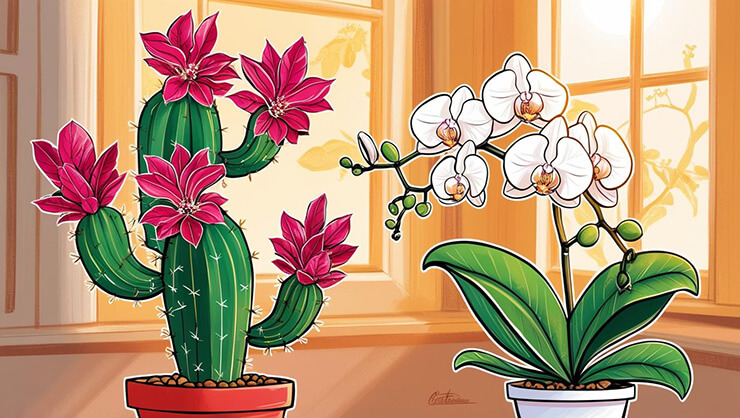Read by Matilda Longbottom

Oh, the agony. To be so close to the object of your desire and, yet, so far away. Feathery toes almost touching, but never able to mingle in the same warm bed of soil. Love, cleaved. Destined to reach, forever.
Christmas Cactus was bought as a scrappy little plant in the discount section of a hardware store. Near death on arrival, it never produced the requisite pink seasonal blossoms. It did not thrive, but it was alive, and I was okay with that.
Orchid was, well, I didn’t even know what Orchid was. It was a centerpiece on a table at an event that I got to take home. Thick glossy leaves with odd spiky stems, I was more interested in the pot than the plant at the time.
I put Christmas Cactus next to Orchid and forgot about them both, save for weekly waterings. My living room is more of a foyer than an actual living space for people. There is either a door or a window on every wall, making the pleasing arrangement of furniture nearly impossible. Its many openings, however, make it a perfect vessel of diffused light.
Christmas Cactus and Orchid sat quietly next to each other for about six months before I noticed their thing. Though they sat side by side, Orchid’s closest window faced east, and Christmas Cactus’ faced south. Neither of them was in direct contact with the sun, but both benefited from the distinct cross rays of a southeast or east-south exposure.
Auxin is a hormone that causes plants to elongate and grow. Under normal light conditions, auxins are generally spread out evenly throughout a plant. But when sunlight varies or is concentrated in a particular area like a leaf or stem, auxin is broken down or reduced on the sunnier side, leaving a higher concentration of auxin on the shady side. This causes the plant cells on the shady auxin-rich side to grow more and to bend toward the light.
I’m not sure when I first noticed Orchid reaching for Christmas Cactus. It was subtle at first. A long spike shot out, then another, and one stood straight. I was a little concerned that Orchid might be trying to consume Christmas Cactus, but saw that something remarkable was happening there, too. Once tiny and withered, Christmas Cactus had nearly doubled in size and was reaching out, too, toward Orchid.
Summer turned to Fall, and the light changed but continued to softly stream in. I became fascinated with what I was witnessing and spent time with the two plants each day. I asked how they were doing, would they like more water, and what they thought of the changing seasons. They responded by growing more and more lovely, and closer to each other every day. I was anxious daily to see what would happen next.
Orchid suddenly burst out the most beautiful inflorescence that I had ever witnessed and fully, finally disclosed that, indeed, it was a magnificent white Phalaenopsis Amabilis orchid. Very soon after that, Christmas Cactus erupted into a cascading waterfall of long pink blossoms, clearly signaling what it was truly made of. I almost cried.
I felt like I had been witnessing a secret, very slow-moving love affair for months, and here now was the vivid climax. The colorful show lasted for weeks. I know it was the setting, auxins, and an enhanced level of interest and care that made the plants do what they did, but I like to think it was love. A star-crossed, hormone-rich, interspecies love affair, played out on a photosynthetic spectrum of soft light. ❖
About the Author: Kimberely Steadman is an emerging nonfiction writer, poet, and artist with a background in technology and professional communications. She uses humor and insight to tell captivating stories in a variety of media. Kimberely enjoys spending time in her greenhouse and garden. A lifelong learner, she recently earned an honors certificate in horticulture from the University of Guelph. Kimberely resides in Kamloops, BC.


 Previous
Previous


I love this story!
Thank you!
Love your story. You are such an articulate & moving writer. Your story resonances with me as my orchid & Christmas also have a mutually symbiotic relationship in spite of my neglect.
Love your story. You are such an articulate & moving writer. Your story resonances with me as my orchid & Christmas also have a mutually symbiotic relationship in spite of my neglect.
Really? I wonder if it really is a ‘thing’?! Thanks for the lovely comments!
Oh my goodness, I love everything about this story! The imagery, the science, the origin story and the birth of color! So well done
Hi Marcia, I’m so glad you liked the story!
I love this! I’ll never look at my plants the same again. I have grouped some together in windows in the sunlight, and made time to really look after them. I’ll see what they do next.
I feel the same, I now consider who gets placed with who! Glad you liked the story!
This is wonderful warming story is truly a fun read. I believe I will team together some of my lonelier looking plants. Thank you for this great article !
So glad you liked the story! Love to know if your plants respond the same way!
Unexpected partners who made each other better. What a sweet story.
So glad you enjoyed the story!
Adorable ☺️
So glad you liked it!
Alone, they suffered, however, put next to each other, love, life and flowers did bloom! This is a beautiful story. I don’t like any plant to be by itself. Even when I can now only do hydroponic growing in this office, there is never a lone tank! Kudos!
Thank you so much for the positive comments. “Never a lone tank!” Love it!